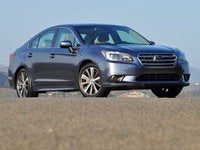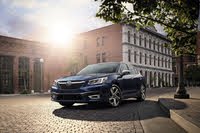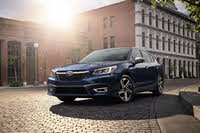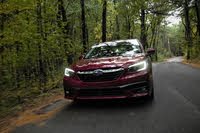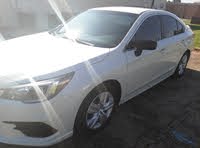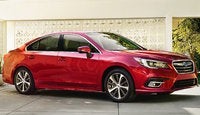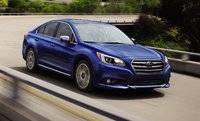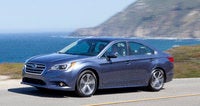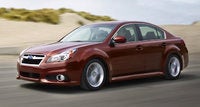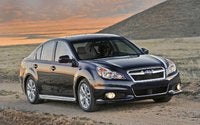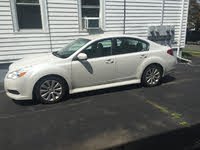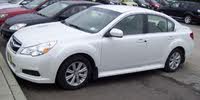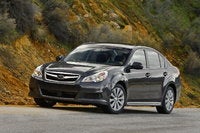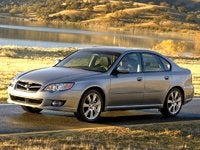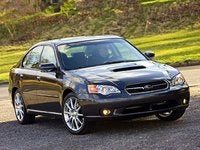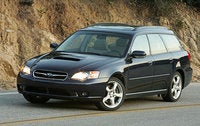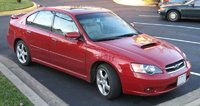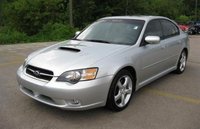Subaru Legacy Model Overview
About the Subaru Legacy
Available Now
Most midsize sedans are precisely the same - 4 doors, 4 wheels, 4 cylinders and no forethought - but Subaru’s Legacy has always chosen its own path. However, some of the configurations and style quirks introduced last year left drivers wondering if the design department was moved beneath a rock. With few changes this year, it’s probably a really big rock.
Subaru dropped the Legacy’s mid-grade Premium GT trim for 2011, upgrading the high-end Limited GT to fill the gap, but leaving a still-too-many total of 7 different configurations. While this lineup certainly secures a few sales jobs and is aimed at providing something for everyone from Honda Accord enthusiasts to Audi A4 executives, the lackluster 6-speed manual transmission available in most trims leaves a gaping hole in an otherwise strong spread - if you like Subaru’s new style.
The 2011 Legacy’s 7 trims are sorted by block size with the 2.5i, 2.5i Premium, 2.5i Limited, and 2.5GT Limited trims getting a 2.5-liter 4-cylinder boxer engine, and the 3.6R, 3.6R Premium, and 3.6R Limited trims getting a 3.6-liter, 256-hp 6-cylinder boxer engine. The 2.5GT stands apart as the only turbocharged option, boosting the 2.5-liter’s power from 170 hp to 265 hp.
That sluggish 6-speed manual transmission is standard with the 2.5i and 2.5i Premium for a laggard 19 mpg city/27 highway, but a continuously variable automatic transmission (CVT) is optional with the two lower trims and standard in the 2.5i Limited for 23/31. Highway acceleration is a big weakness.
The 3.6R trims get a traditional and uninspiring 5-speed automatic for 18/25, again with the lazy 6-speed manual as an option, but the 2.5GT offers only a modified 6-speed manual for the same fuel economy, and it’s considerably more precise than that of any other trim - and devilishly fun. As always, Subaru’s manual transmission features hill-holding capabilities.
Standard equipment in the 2011 Legacy from the 2.5i upward includes 16-inch steel wheels, air conditioning, cruise control, power accessories, height-adjustable driver seat and steering wheel, 60/40-split folding rear seat, stability and traction control, antilock disc brakes, front side and side curtain airbags, 4-speaker stereo with CD player, auxiliary audio jack and steering-wheel-mounted controls.
The Premium adds 16-inch alloy wheels, leather details and a few more power accessories. Limited trims get 17-inch alloy wheels and add passenger seat power, dual-zone climate control, an All Weather package, Bluetooth, and a 9-speaker Harman Kardon sound system with 6-CD changer and subwoofer.
The correlating 3.6R trims are not much different, except each gets 17-inch alloys and bigger brakes. The All Weather package available as an option for the 2.5i Premium and standard on the Limited trims is standard for the 3.6R Premium.
The 2.5GT Limited gets 18-inch alloys and everything from the 3.6R Limited, plus summer tires, hood scoop, sunroof (an option on everything but the 2.5i), foglights, unique interior style and satellite radio. Options for this and all Limited trims include a touchscreen navigation system, voice controls, rear-view camera, Bluetooth phone and audio connectivity, and a different Harman Kardon sound system with CD player, USB connectivity and iPod controller.
While this spread certainly affords an option for every driver, no trim is exactly as you would expect. The economy trims are not as fuel efficient as your typical 4-banger, acceleration is downright awful at highway speeds and the base stereo is quite weak and lacks the amenities so commonly offered in other, similarly priced cars, like iPod controls and Bluetooth connectivity.
In the middle of the road, the 6-cylinder’s fuel economy is lacking, too, acceleration could be better, and the navigation system has the temperament of a tired toddler. The 2.5GT - although definitely one of the priciest trims - doesn’t have the option of an automatic and lacks a sport-tuned suspension, leaving its turbocharged engine high and dry on curves.
The Premium trims offer luxury with excellent visibility, a spacious cabin, standard all-wheel drive and all the gizmos you could want - along with Subaru’s characteristically odd style.
Model History
A mere 6 months after the Legacy’s February 1989 launch in Japan, it was already here in the States giving resident makers a hard time, taking a good chunk out of the midsize market. With its sights set on buyers of every midsize from the Toyota Camry all the way to the Audi A4, Subaru made its Legacy something everyone could love and afford. Contrary to popular belief, the Legacy wasn’t always all-wheel drive (AWD). While it was always available, AWD wasn’t the status quo until ‘97, following the wild success of the Outback.
For the Legacy’s introduction to North America, Subaru offered a base wagon and sedan with front-wheel drive only, 14-inch all-season steel wheels and either a 5-speed manual with Hill Holder clutch or a 4-speed automatic transmission. Only the wagon came with a fold-flat rear seat, as always, but neither came with air conditioning.
The L and LS wagons and sedans made AWD available, along with a few other upgrades. The L added to the base ABS with the automatic transmission, full power accessories and the option of air conditioning. The LS gained alloy wheels, standard air conditioning, power sunroof and leather interior, and all trims were powered by the same 2.2-liter, 130-hp inline 4-cylinder Boxer engine.
A Sport Sedan and LSi luxury edition joined the lineup in 1991. This time alloy wheels, full power accessories, cruise control, air conditioning, leather seats and details, along with a boatload of gizmos and compartments, were standard on all but the L, which got only some of those as options and, as always, steel wheels instead of the alloys.
The Sport sedan was the only offering with a new engine - a turbocharged 2.2-liter, 160-hp Boxer complete with sport-tuned suspension, larger brakes and 15-inch tires on alloy rims. While the other trims offered AWD as an option, AWD was the only way you could get the Sport sedan.
The ‘92 Legacy went under the knife for a slight facelift, with a new driver-side airbag standard in all but the L and Sport and optional otherwise. Also all but the L gained a pass-through opening in the rear seat along with a few other finishing touches like cupholders and ducts.
Those additions became standard in ‘93 across the board, and a Touring Wagon joined the lineup, borrowing the Sport sedan’s turbocharged engine. Like the Sport, AWD is the only way the Touring goes, but with the automatic transmission standard instead of the manual.
Fans of the brand are certain to be most familiar with the second-generation Legacy, featuring the ever-popular SUV-alternative Outback wagon. The ‘95 Legacy underwent a total overhaul, dropping the Sport sedan and “lifestyle” trims of the previous year, gaining 5 horsepower in the same engine and growing 2 inches in length with 2 all-new wagon trims - the bargain basement Brighton and the rugged Outback.
Only the L came standard as front-wheel drive, with AWD as an option for it but standard in all other versions. As always, you can pick your transmission, but the LS and LSi came standard with the automatic, while all others came standard with the hill-holding manual. Dual airbags came standard on all models this time, with antilock brakes optional on the L and standard otherwise except for the Brighton, which lacked antilock brakes altogether.
For ‘96 again only the L came with front-wheel drive, and the Outback got prettier, headroomier, and another inch of clearance. The LSi wagon gained a bigger 2.5-liter, 155-hp Boxer engine that it shared with the all-new AWD 2.5GT sedan and wagon, which also came standard with the automatic transmission.
Then came the grand transition - no trim was anything but AWD from ‘97 on out. The 2.2-liter engine in the L and Brighton gained 2 horses for a total of 137, and the 2.5-liter in the GT, LSi, Outback and all-new premium Limited trims gained 10, up to 165 hp. The 5-speed manual now featured overdrive, and you could choose it or a 4-speed automatic.
Nothing major changed for ‘98, but the changes in ‘99 gave the Outback a quieter cabin and the new Outback Limited featured a distinctive style with final touches on the grille, exterior mirrors and alloy wheels. All the big changes were still under the covers, laying in wait for the 2000 complete redesign.
The all-new 2000 Legacy, and the entire third generation to follow, was built to be an all-weather warrior, complete with a “Ring-Shaped Reinforcement” body structure and beams in the doors to protect against any worst case scenario. The trim lineup got shuffled around with the Brighton as the baseline wagon followed by the L and GT, and for sedans the L was the baseline, followed by the GT and GT Limited.
All were powered by a livelier, single-overhead-cam version of the former generation’s larger engine, a 2.5-liter, 165-hp Boxer getting about 18/25 mpg. Once again you could choose a 5-speed hill-holding manual or 4-speed automatic.
Along with much improved style and extensive safety additions including ABS all around, the new and improved all-weather option packages now include a limited-slip rear differential, multi-reflection headlights for the GT sedan and a double moonroof for the GT wagon. The Legacy, in all forms, was now ready for anything.
The bargain Brighton was taken out for 2001, options were added as standard features, including a rear wiper for the L wagon, and the all-weather package was now default equipment for the GT trims. For 2002, more all-weather options were made standard, like a windshield wiper de-icer and heated seats and outside mirrors. The GT trims got bigger brakes and a few new interior touches.
For 2003 the GT and GT Limited trims became the 2.5GT with all the fixings of the previous GT Limited plus an upgraded sound system with 6-CD changer and a Sportshift manual mode for the optional 4-speed automatic. The new L Special Edition featured much of the previous GT equipment, and all models got a new front end and two new standard features - a CD player and keyless entry.
The previous year’s L Special Edition became Subaru’s 35th anniversary gift in the third generation’s final year, now with 16-inch alloy wheels, 6-way power driver seat, leather details, sunroof and an anniversary emblem everywhere Subaru could put one. The other trims just got a couple new interior colors to spark sales before the grand redesign.
The 2005 Legacy emerged from the drawing table a totally new machine, complete with a fresh professional style inside and out. The 2.5i and 2.5i Limited sedans and wagons sported a 2.5-liter, 168-hp Boxer getting between 20 and 27 miles to the gallon with the 5-speed manual or 4-speed automatic. The 2.5GT and 2.5GT Limited sedans and wagons ran on a 250-hp turbocharged version for 17/23 mpg with the 5-speed manual or 5-speed automatic.
Safety was vastly upgraded with a buffet of airbags and new features, and even the most baseline model came with luxury amenities like cruise control, power accessories and all the trimmings you would expect if you paid several thousand more - even alloy wheels.
The 2006 changes saw the beginnings of a smarter Subaru lineup. Some would call it unnecessarily confusing, others call it a genius convenience. From here on out, Subaru focused on a more tailored approach - taking the manual transmission out of the GT wagon only, for instance - to make each Legacy a unique gift for just the right driver.
The Legacy lineup now included 2.5i, 2.5i Special Edition, 2.5i Limited, and 2.5GT Limited sedans and wagons, with a 2.5GT Spec B sedan as well - dropping the 2.5GT baseline altogether.
The 2.5i models now featured new valvetrain technology, gaining 7 horses over the previous 168 hp, and also sported new standard features, such as bigger 17-inch alloy wheels, upgraded brakes, air filtration and an engine immobilizer - but the 2.5i Limited sedans and wagons and the 2.5GT Limited wagon offered only an automatic transmission.
Last and best was the limited-production 2.5GT Spec B with a super-firm sport suspension, 18-inch alloy wheels, DVD-based navigation system also available in select other trims, ground effects and alloy pedals. Powering the Spec B was the same 250-hp turbocharged Boxer in the other GT trims, but with significantly better handling thanks to the upgraded suspension.
The Spec B sedan got an upgrade for 2007, not just in terms of becoming a regular production model, but Subaru also replaced the previous 5-speed manual transmission with an exclusive 6-speed and added a limited-slip rear differential.
Engine upgrades along with a new turbocharger made both the Spec B and GT Limited ready for LEV 2 emissions standards while cutting just 7 horses from the engine’s power. These turbo Legacys also gained the ability to tweak engine responsiveness through a special SI-Drive feature along with a tire pressure monitor and other additional gizmos.
Following suit with its strategy to build a custom car for anyone, Subaru gave the 2.5i Special Edition wagon dual moonroofs, while the sedan got just one oversized moonroof. The Spec B got exclusive illuminated instruments, but wasn’t at all available as a wagon. Legacy wagons take only the automatic transmission - except for the 2.5i baseline model, which can use the 5-speed manual. These sorts of quirky here-not-there special features are still present everywhere in the Legacy lineup to this day.
However, all ‘07 Legacys now featured, above and beyond previous models, an MP3 and WMA capable CD player and audio jack, with a special SRS WOW equalizer for improving compressed media formats in select higher-end trims. XM satellite radio became an option across the board, and the default 5-speed manual saw a few improvements.
If you were hoping for an ‘08 or newer wagon, you won’t find one. Subaru has produced exclusively sedans for the Legacy since the 2008 model year, including the usual 2.5i, 2.5i Special Edition, 2.5i Limited, 2.5 GT Limited, and the 2.5 GT Spec B, plus a newcomer - the 3.0R Limited.
As you might imagine, the 3.0R Limited is powered by a 3-liter Boxer engine, but the surprise is a Legacy with 6 flat cylinders at long last, for 245 hp out of the paddle-shifted automatic transmission. The fuel economy - and all other features, for that matter - are precisely the same as you would find in the 2.5GT Spec B, going 17 miles to the gallon in the city and 24 on the highway. The 2.5GT Limited still got 19/24 mpg, but the fuel economy on lower level trims improved to 20/27.
The ‘08 Legacy also received a bit of a makeover with a new instrument panel, style accessories, and tilt and telescoping steering wheel, but stability and traction control, while at least optional on mid-level trims and above, were still unavailable to the baseline trims.
The 2009 Legacy changed that, making stability control standard for almost every model - including the new 3.0R joining the 3.0R Limited - but excepting the 2.5GT models with a manual transmission. All but the 2.5i baseline Legacy also gained an upgraded 9-speaker stereo. The 3.0R and 2.5GT models quickly became a favorite for their sporty feel and acceleration with the added bonus of an exclusive navigation system on all but the baseline 3.0R and manual 2.5GT Limited.
Unfortunately Subaru made a big stylistic leap of faith for the 2010 overhaul, stepping away from the previous generation’s sleek appeal in favor of a somewhat flabby look that has attracted a great deal of criticism. Some of the interior touches seem gaudy, while the exterior would probably fit better on an SUV, but if you dare to look beneath the cover, there is still a lot to appreciate.
The previous 3-liter engine was upgraded to a 3.6-liter engine, so the former 3.0R is now the 3.6R, and that trim level along with the 2.5GT gained a new midlevel Premium model. The only true difference between the Premium and Limited models is that the Premium models can’t get Limited-exclusive features like a voice-activated navigation system, iPod/USB input, Bluetooth, streaming Bluetooth audio and a back-up camera.
Along with dropping the 2.5GT Spec B trim altogether, the Legacy gained roughly 3 inches in every dimension and a totally new suspension for a marked improvement in cabin comfort, but this completely killed the former generation’s sporty appeal by eliminating the only sport-tuned option.
The upgrade from a 3-liter to a 3.6-liter Boxer engine in the 3.6R trims actually increased fuel economy in that trim level and the 2.5GT models by 1 mile per gallon, while the fuel economy of the other trims remained basically the same except for the 2.5i Limited, which improved by 4 mpg to 23/31 due to the Limited’s standard CVT transmission technology, otherwise optional in the 2.5i Premium only.
Although most kids would be proud to say, “That’s my mom’s car,” given the style and feature-set changes in this generation, those children would be stating the obvious.
Used Versions
Overall, Subarus are exceptionally reliable, but before you get any used Subaru, check into whether the sensors (oxygen sensor, mass air flow sensor and the like) have been replaced - almost every single year has an issue with those. The ‘92 and older Legacys have a solenoid issue. Anything older than a ‘94 will need to have the A/C coolant converted, and ‘94 Legacys often suffer complete suspension failure.
While you can get a first-generation Subaru for $2,000 or less, expect to spend your purchase price once again on maintenance costs over the next year. The good news is that any ‘94 or older Legacy still driving today is absolutely solid otherwise and guaranteed to make it to the mechanic’s shop under its own power - but expect to be there fairly often.
Going into the second generation, including the famous Outback, only minor sensor issues cropped up, with no real problems reported for ‘96 versions either. However, ‘97 and ‘98 manuals fail to go into neutral, and this was the beginning of the Legacy’s notorious head gasket and catalytic converter issues. For the ‘99, automatic transmission failure joins the party.
The ‘95 and ‘96 Legacys are a steal for all their reliability, between $1,800 and $2,700. Newer years start at $2,000 and skyrocket more than $500 each year thereafter, since AWD became the Legacy standard in ‘97, and demand is high despite the issues. For instance, the ‘99 30th Anniversary sedan goes for over $4,000 despite the fact that it’s the only model with the problematic automatic transmission - but the L sedan with next to zero issues is barely over $3,300, with the upper trims just $600 more.
The 2000 Legacy is a flat do-not-buy unless the sensors, catalytic converter, head gaskets and automatic transmission have already been replaced. The automatic transmission issues were fixed for the ‘01, the catalytic converter issues fixed in the ‘02, and by ‘03 the last remaining worry are the head gaskets. The ‘04 was rated the most reliable car, with absolutely zero serious issues.
These third-generation Legacys start at $4k and reach all the way up to $9k for the ‘04. While you can get a 2000 between $4k and $5k, it’s not exactly the best year. The ‘01 starts at $4,500, but you can get a better (i.e., working) automatic for the same $5k you would pay for a 2000. The ‘02 is a significantly better car, and the price reflects it, starting at $6k and ranging up to $7,500. The ‘03 is about $500 more for the same car, but the most in-demand Legacy - the ‘04 - starts at $7,500 and almost breaks $10k. If you can get an ’04, do.
The ‘05 had a bit of an issue with the usual sensors and catalytic converter, but those were apparently fixed in all future models. Of course the true reliability of anything newer than ‘07 is really anyone’s guess, but if this pattern holds - stay away from the first-year engines and transmissions.
Unfortunately, if you were hoping for an inexpensive, highly reliable, lightly used Legacy, think again. Fourth-generation versions start at nearly $9k. These years are in exceptionally high demand for their sleek appeal and wagon models, and even an ‘05 could cost you $12,000. The starting price on an ‘06 bumps up a grand and doesn’t cap out until $16,500 for the Spec B. An ‘07 ranges from $12k to $20k, and you’ll pay $2,000 more for the same car a year newer for the next 2 years.
Overall, drivers love their Legacy - no matter how old, no matter how used, it still runs like a champ. However, every now and then a lemon makes it out of the factory, and you’ll be stuck in and out of repair shops for as long as you own it. Legacys are either exceptionally reliable or decidedly not, but if the one you get isn’t quite what you hoped, the good news is you can get another one and probably have better luck.
New Subaru Legacy



Used Subaru Legacy
Subaru Legacy Questions
My 2012 Legacy Crank's But Will Not Start.
I thought it was fuel pump so i did replace and the car cranks with no issues but not getting any fuel at the injectors. anyone ran across this issue?
What Subaru Vehicles Can Accept An 07 2.5i Limited For A Motor Swap?
what subaru vehicles and their year can accept a 2007 2.5i limited for a motor swap? Own an 07 legacy wagon and want to take my motor out of it and put it in another subaru but 07 legacy wagons are ...
Engine Swap
I have a 2001 Subaru Legacy GT Limited that needs a motor, would one from a Forester be a plug and go swap?
I Have A 2005 Legacy Wagon 2.5i...not An Outback. 3 Cats And 5 O2s
I have a 2005 Legacy 2.5i wagon not an outback. It has 3 Cats and 5 O2 sensors. I can not find this system anywhere. I did see someplace that it could have been a CA model. Please help. Frank
